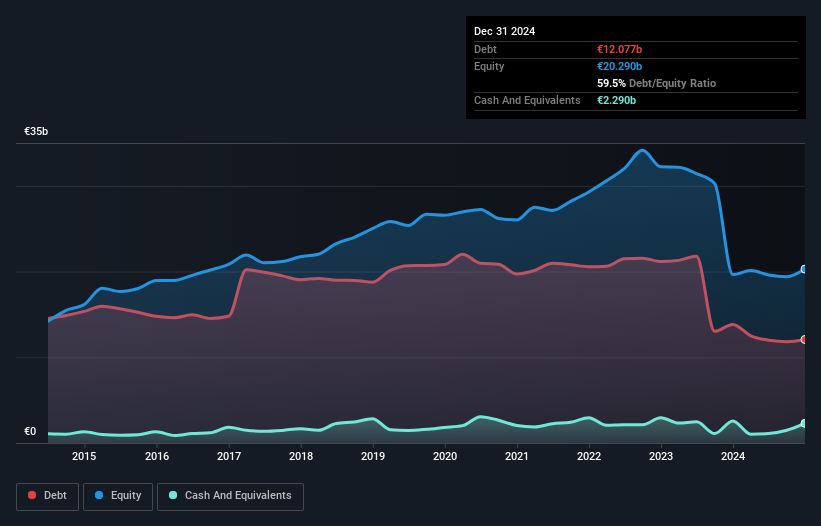
Some say volatility, rather than debt, is the best way to think about risk as an investor, but Warren Buffett famously said that 'Volatility is far from synonymous with risk.' It's only natural to consider a company's balance sheet when you examine how risky it is, since debt is often involved when a business collapses. We note that Fresenius SE & Co. KGaA (ETR:FRE) does have debt on its balance sheet. But is this debt a concern to shareholders?
When Is Debt Dangerous?
Debt and other liabilities become risky for a business when it cannot easily fulfill those obligations, either with free cash flow or by raising capital at an attractive price. Ultimately, if the company can't fulfill its legal obligations to repay debt, shareholders could walk away with nothing. While that is not too common, we often do see indebted companies permanently diluting shareholders because lenders force them to raise capital at a distressed price. Of course, plenty of companies use debt to fund growth, without any negative consequences. When we think about a company's use of debt, we first look at cash and debt together.
How Much Debt Does Fresenius SE KGaA Carry?
You can click the graphic below for the historical numbers, but it shows that Fresenius SE KGaA had €12.1b of debt in December 2024, down from €13.8b, one year before. However, because it has a cash reserve of €2.29b, its net debt is less, at about €9.79b.

A Look At Fresenius SE KGaA's Liabilities
Zooming in on the latest balance sheet data, we can see that Fresenius SE KGaA had liabilities of €9.01b due within 12 months and liabilities of €14.3b due beyond that. On the other hand, it had cash of €2.29b and €5.51b worth of receivables due within a year. So its liabilities outweigh the sum of its cash and (near-term) receivables by €15.5b.
This deficit is considerable relative to its very significant market capitalization of €22.5b, so it does suggest shareholders should keep an eye on Fresenius SE KGaA's use of debt. Should its lenders demand that it shore up the balance sheet, shareholders would likely face severe dilution.
Check out our latest analysis for Fresenius SE KGaA
We use two main ratios to inform us about debt levels relative to earnings. The first is net debt divided by earnings before interest, tax, depreciation, and amortization (EBITDA), while the second is how many times its earnings before interest and tax (EBIT) covers its interest expense (or its interest cover, for short). The advantage of this approach is that we take into account both the absolute quantum of debt (with net debt to EBITDA) and the actual interest expenses associated with that debt (with its interest cover ratio).
Fresenius SE KGaA's debt is 3.8 times its EBITDA, and its EBIT cover its interest expense 4.1 times over. This suggests that while the debt levels are significant, we'd stop short of calling them problematic. Looking on the bright side, Fresenius SE KGaA boosted its EBIT by a silky 43% in the last year. Like the milk of human kindness that sort of growth increases resilience, making the company more capable of managing debt. There's no doubt that we learn most about debt from the balance sheet. But ultimately the future profitability of the business will decide if Fresenius SE KGaA can strengthen its balance sheet over time. So if you're focused on the future you can check out this free report showing analyst profit forecasts.
Finally, a business needs free cash flow to pay off debt; accounting profits just don't cut it. So the logical step is to look at the proportion of that EBIT that is matched by actual free cash flow. Happily for any shareholders, Fresenius SE KGaA actually produced more free cash flow than EBIT over the last three years. That sort of strong cash generation warms our hearts like a puppy in a bumblebee suit.
Our View
Happily, Fresenius SE KGaA's impressive conversion of EBIT to free cash flow implies it has the upper hand on its debt. But truth be told we feel its net debt to EBITDA does undermine this impression a bit. It's also worth noting that Fresenius SE KGaA is in the Healthcare industry, which is often considered to be quite defensive. All these things considered, it appears that Fresenius SE KGaA can comfortably handle its current debt levels. On the plus side, this leverage can boost shareholder returns, but the potential downside is more risk of loss, so it's worth monitoring the balance sheet. There's no doubt that we learn most about debt from the balance sheet. However, not all investment risk resides within the balance sheet - far from it. For example - Fresenius SE KGaA has 2 warning signs we think you should be aware of.
At the end of the day, it's often better to focus on companies that are free from net debt. You can access our special list of such companies (all with a track record of profit growth). It's free.
New: AI Stock Screener & Alerts
Our new AI Stock Screener scans the market every day to uncover opportunities.
• Dividend Powerhouses (3%+ Yield)
• Undervalued Small Caps with Insider Buying
• High growth Tech and AI Companies
Or build your own from over 50 metrics.
Have feedback on this article? Concerned about the content? Get in touch with us directly. Alternatively, email editorial-team (at) simplywallst.com.
This article by Simply Wall St is general in nature. We provide commentary based on historical data and analyst forecasts only using an unbiased methodology and our articles are not intended to be financial advice. It does not constitute a recommendation to buy or sell any stock, and does not take account of your objectives, or your financial situation. We aim to bring you long-term focused analysis driven by fundamental data. Note that our analysis may not factor in the latest price-sensitive company announcements or qualitative material. Simply Wall St has no position in any stocks mentioned.
About XTRA:FRE
Fresenius SE KGaA
A health care company, provides products and services for chronically ill patients.
Good value with adequate balance sheet and pays a dividend.
Similar Companies
Market Insights
Community Narratives




